heating KIA Soul 2013 1.G Owner's Manual
[x] Cancel search | Manufacturer: KIA, Model Year: 2013, Model line: Soul, Model: KIA Soul 2013 1.GPages: 393, PDF Size: 8.76 MB
Page 5 of 393
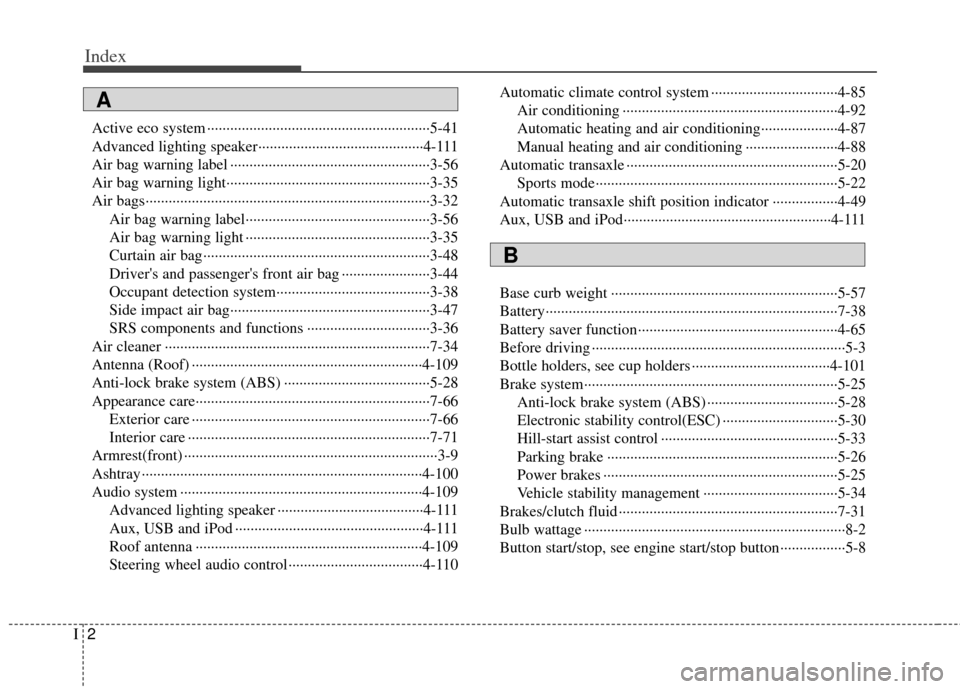
Index
2I
Active eco system ··················\
··················\
··················\
····5-41
Advanced lighting speaker··················\
··················\
·······4-111
Air bag warning label ··················\
··················\
················3-56
Air bag warning light··················\
··················\
·················3-35\
Air bags··················\
··················\
··················\
··················\
··3-32Air bag warning label··················\
··················\
············3-56
Air bag warning light ··················\
··················\
············3-35
Curtain air bag··················\
··················\
··················\
·····3-48
Driver's and passenger's front air bag ··················\
·····3-44
Occupant detection system··················\
··················\
····3-38
Side impact air bag··················\
··················\
················3-47
SRS components and functions ··················\
··············3-36
Air cleaner ··················\
··················\
··················\
···············7-34
Antenna (Roof) ··················\
··················\
··················\
······4-109
Anti-lock brake system (ABS) ··················\
··················\
··5-28
Appearance care··················\
··················\
··················\
·······7-66 Exterior care ··················\
··················\
··················\
········7-66
Interior care ··················\
··················\
··················\
·········7-71
Armrest(front) ··················\
··················\
··················\
············3-9
Ashtray ··················\
··················\
··················\
··················\
·4-100
Audio system ··················\
··················\
··················\
·········4-109 Advanced lighting speaker ··················\
··················\
··4-111
Aux, USB and iPod ··················\
··················\
·············4-111
Roof antenna ··················\
··················\
··················\
·····4-109
Steering wheel audio control··················\
·················4-110 Automatic climate control system ··················\
···············4-85
Air conditioning ··················\
··················\
··················\
··4-92
Automatic heating and air conditioning··················\
··4-87
Manual heating and air conditioning ··················\
······4-88
Automatic transaxle ··················\
··················\
··················\
·5-20 Sports mode··················\
··················\
··················\
·········5-22
Automatic transaxle shift position indicator ·················4-49\
Aux, USB and iPod··················\
··················\
··················\
4-111
Base curb weight ··················\
··················\
··················\
·····5-57
Battery··················\
··················\
··················\
··················\
····7-38
Battery saver function··················\
··················\
················4-65
Before driving ··················\
··················\
··················\
············5-3
Bottle holders, see cup holders ··················\
··················\
4-101
Brake system··················\
··················\
··················\
············5-25 Anti-lock brake system (ABS) ··················\
················5-28
Electronic stability control(ESC) ··················\
············5-30
Hill-start assist control ··················\
··················\
··········5-33
Parking brake ··················\
··················\
··················\
······5-26
Power brakes ··················\
··················\
··················\
·······5-25
Vehicle stability management ··················\
·················5-34\
Brakes/clutch fluid ··················\
··················\
··················\
···7-31
Bulb wattage ··················\
··················\
··················\
··············8-2
Button start/stop, see engine start/stop button·················5-8
A
B
Page 9 of 393
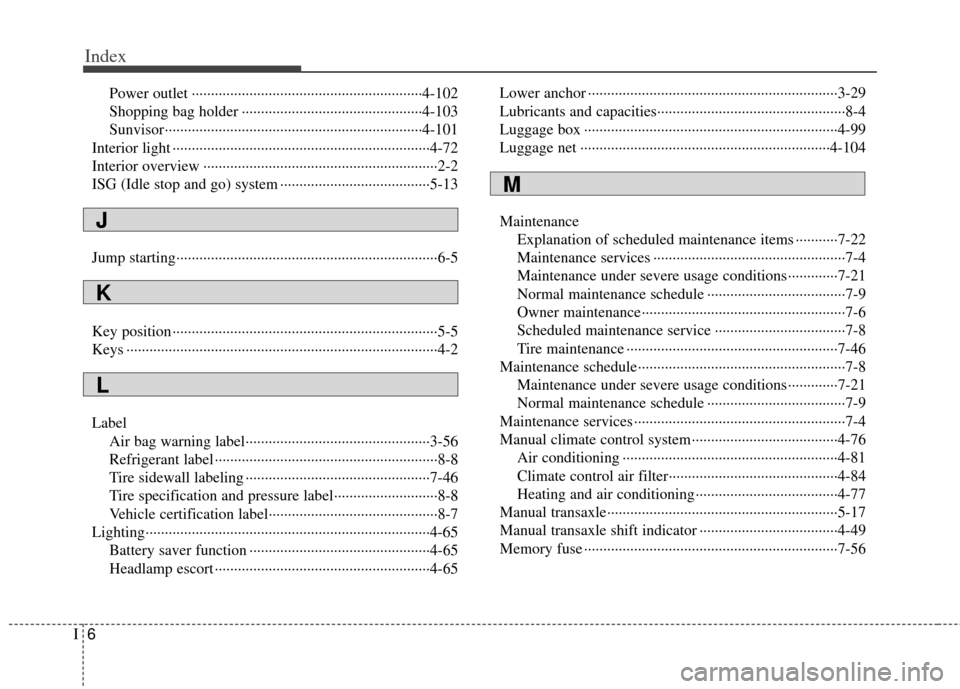
Index
6I
Power outlet ··················\
··················\
··················\
······4-102
Shopping bag holder ··················\
··················\
···········4-103
Sunvisor··················\
··················\
··················\
·············4-101
Interior light ··················\
··················\
··················\
·············4-72
Interior overview ··················\
··················\
··················\
·······2-2
ISG (Idle stop and go) system ··················\
··················\
···5-13
Jump starting··················\
··················\
··················\
··············6-5
Key position ··················\
··················\
··················\
···············5-5
Keys ··················\
··················\
··················\
··················\
·········4-2
Label Air bag warning label··················\
··················\
············3-56
Refrigerant label ··················\
··················\
··················\
····8-8
Tire sidewall labeling ··················\
··················\
············7-46
Tire specification and pressure label··················\
·········8-8
Vehicle certification label··················\
··················\
········8-7
Lighting··················\
··················\
··················\
··················\
··4-65 Battery saver function ··················\
··················\
···········4-65
Headlamp escort ··················\
··················\
··················\
··4-65 Lower anchor ··················\
··················\
··················\
···········3-29
Lubricants and capacities··················\
··················\
·············8-4
Luggage box ··················\
··················\
··················\
············4-99
Luggage net ··················\
··················\
··················\
···········4-104
Maintenance
Explanation of scheduled maintenance items ···········7-22
Maintenance services ··················\
··················\
··············7-4
Maintenance under severe usage conditions ·············7-21
Normal maintenance schedule ··················\
··················\
7-9
Owner maintenance··················\
··················\
·················7-6
Scheduled maintenance service ··················\
················7-8
Tire maintenance ··················\
··················\
··················\
·7-46
Maintenance schedule··················\
··················\
··················\
7-8 Maintenance under severe usage conditions ·············7-21
Normal maintenance schedule ··················\
··················\
7-9
Maintenance services ··················\
··················\
··················\
·7-4
Manual climate control system··················\
··················\
··4-76 Air conditioning ··················\
··················\
··················\
··4-81
Climate control air filter··················\
··················\
········4-84
Heating and air conditioning··················\
··················\
·4-77
Manual transaxle··················\
··················\
··················\
······5-17
Manual transaxle shift indicator ··················\
··················\
4-49
Memory fuse ··················\
··················\
··················\
············7-56
M
J
K
L
Page 31 of 393
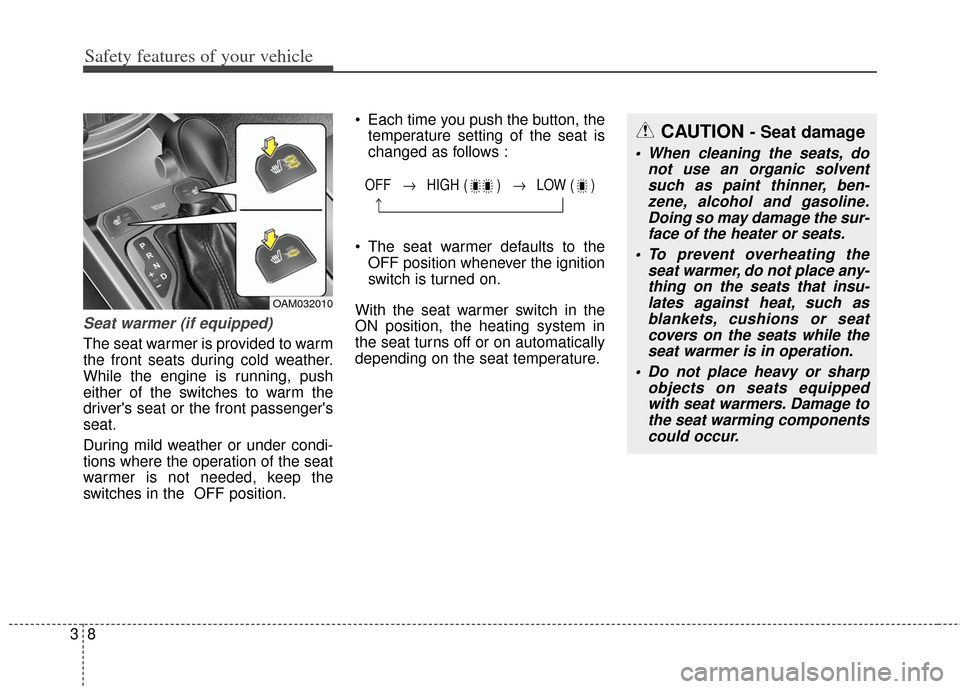
Safety features of your vehicle
83
Seat warmer (if equipped)
The seat warmer is provided to warm
the front seats during cold weather.
While the engine is running, push
either of the switches to warm the
driver's seat or the front passenger's
seat.
During mild weather or under condi-
tions where the operation of the seat
warmer is not needed, keep the
switches in the OFF position. Each time you push the button, the
temperature setting of the seat is
changed as follows :
The seat warmer defaults to the OFF position whenever the ignition
switch is turned on.
With the seat warmer switch in the
ON position, the heating system in
the seat turns off or on automatically
depending on the seat temperature.
OFF → HIGH ( ) → LOW ( )
→
OAM032010
CAUTION - Seat damage
When cleaning the seats, do not use an organic solventsuch as paint thinner, ben-zene, alcohol and gasoline.Doing so may damage the sur-face of the heater or seats.
To prevent overheating the seat warmer, do not place any-thing on the seats that insu-lates against heat, such asblankets, cushions or seatcovers on the seats while theseat warmer is in operation.
Do not place heavy or sharp objects on seats equippedwith seat warmers. Damage tothe seat warming componentscould occur.
Page 32 of 393

39
Safety features of your vehicle
Armrest (if equipped)
To use the armrest, swing down the
armrest to the lowest position.
OSA038123
WARNING - Seat warmerburns
Passengers should use extreme
caution when using seat warm-
ers due to the possibility of
excess heating or burns. The
seat warmer may cause burns
even at low temperatures, espe-
cially if used for long periods of
time. The occupants must be
able to feel if the seat is becom-
ing too warm and to turn the
seat warmer off. The seat
warmer may cause burns even
at low temperatures, especially
if used for long periods of time.
In particular, the driver must
exercise extreme care for the
following types of passengers:
1. Infants, children, elderly or
disabled persons, or hospital
outpatients
2. Persons with sensitive skin or those that burn easily
3. Fatigued individuals (Continued)
(Continued)
4. Intoxicated individuals
5. Individuals taking medicationthat can cause drowsiness or
sleepiness (sleeping pills,
cold tablets, etc.)
Page 121 of 393
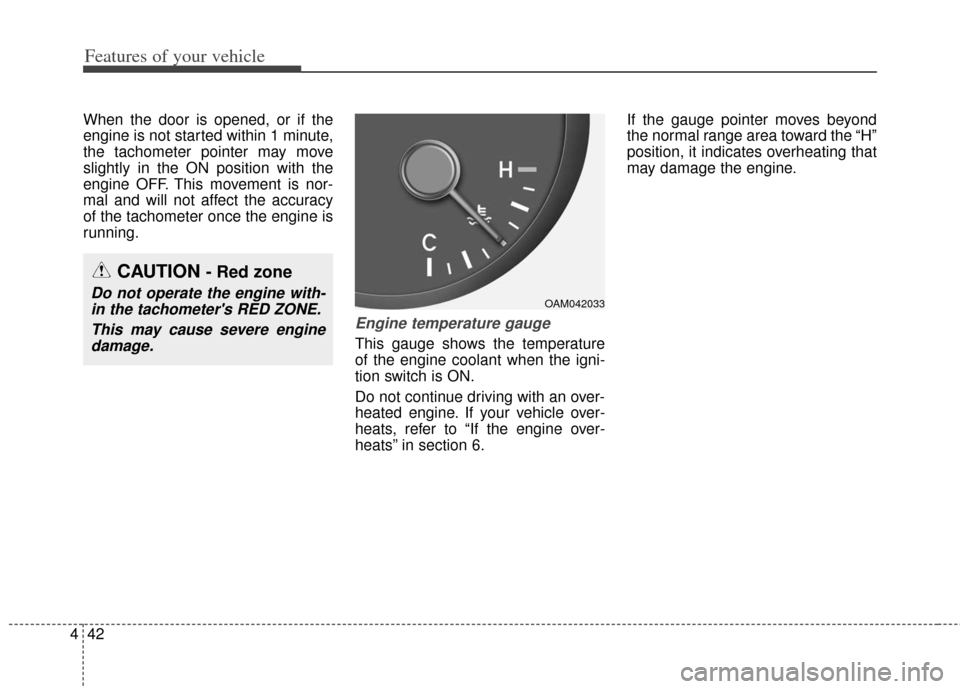
Features of your vehicle
42
4
When the door is opened, or if the
engine is not started within 1 minute,
the tachometer pointer may move
slightly in the ON position with the
engine OFF. This movement is nor-
mal and will not affect the accuracy
of the tachometer once the engine is
running.
Engine temperature gauge
This gauge shows the temperature
of the engine coolant when the igni-
tion switch is ON.
Do not continue driving with an over-
heated engine. If your vehicle over-
heats, refer to “If the engine over-
heats” in section 6. If the gauge pointer moves beyond
the normal range area toward the “H”
position, it indicates overheating that
may damage the engine.
OAM042033
CAUTION - Red zone
Do not operate the engine with-
in the tachometer's RED ZONE.
This may cause severe enginedamage.
Page 156 of 393
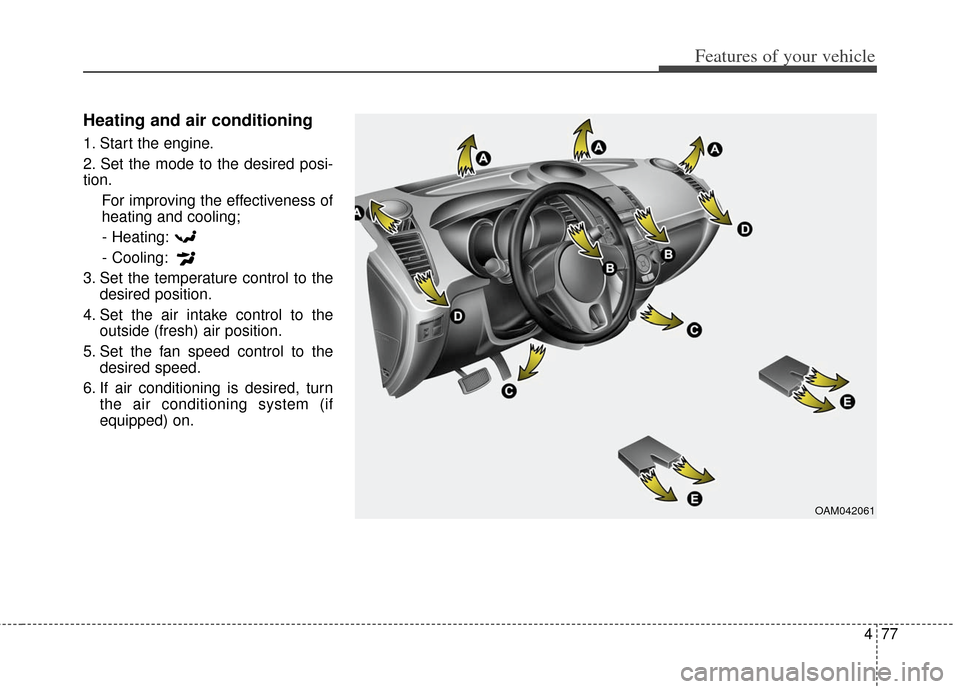
477
Features of your vehicle
Heating and air conditioning
1. Start the engine.
2. Set the mode to the desired posi-
tion.For improving the effectiveness of
heating and cooling;- Heating:
- Cooling:
3. Set the temperature control to the desired position.
4. Set the air intake control to the outside (fresh) air position.
5. Set the fan speed control to the desired speed.
6. If air conditioning is desired, turn the air conditioning system (if
equipped) on.
OAM042061
Page 159 of 393
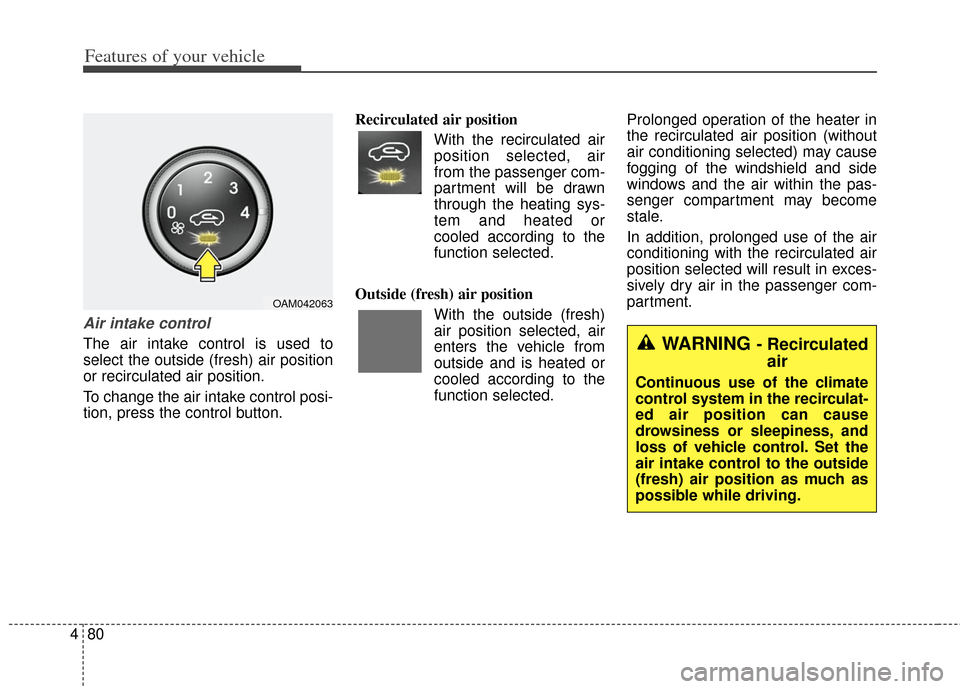
Features of your vehicle
80
4
Air intake control
The air intake control is used to
select the outside (fresh) air position
or recirculated air position.
To change the air intake control posi-
tion, press the control button. Recirculated air position
With the recirculated airposition selected, air
from the passenger com-
partment will be drawn
through the heating sys-
tem and heated or
cooled according to the
function selected.
Outside (fresh) air position With the outside (fresh)
air position selected, air
enters the vehicle from
outside and is heated or
cooled according to the
function selected. Prolonged operation of the heater in
the recirculated air position (without
air conditioning selected) may cause
fogging of the windshield and side
windows and the air within the pas-
senger compartment may become
stale.
In addition, prolonged use of the air
conditioning with the recirculated air
position selected will result in exces-
sively dry air in the passenger com-
partment.
OAM042063
WARNING - Recirculated
air
Continuous use of the climate
control system in the recirculat-
ed air position can cause
drowsiness or sleepiness, and
loss of vehicle control. Set the
air intake control to the outside
(fresh) air position as much as
possible while driving.
Page 161 of 393
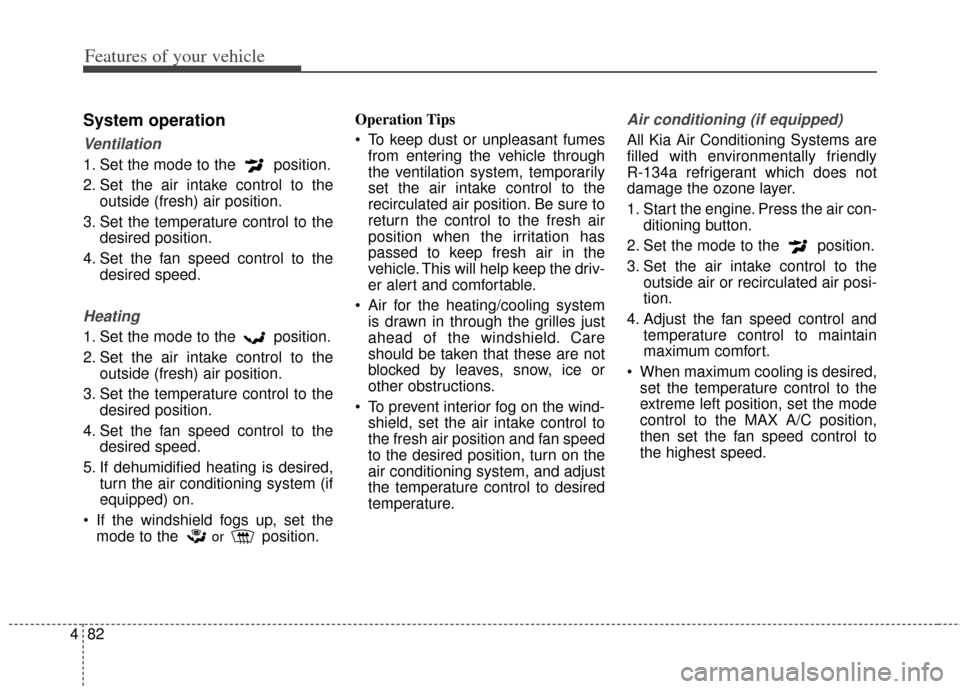
Features of your vehicle
82
4
System operation
Ventilation
1. Set the mode to the position.
2. Set the air intake control to the
outside (fresh) air position.
3. Set the temperature control to the desired position.
4. Set the fan speed control to the desired speed.
Heating
1. Set the mode to the position.
2. Set the air intake control to theoutside (fresh) air position.
3. Set the temperature control to the desired position.
4. Set the fan speed control to the desired speed.
5. If dehumidified heating is desired, turn the air conditioning system (if
equipped) on.
If the windshield fogs up, set the mode to the
orposition. Operation Tips
To keep dust or unpleasant fumes
from entering the vehicle through
the ventilation system, temporarily
set the air intake control to the
recirculated air position. Be sure to
return the control to the fresh air
position when the irritation has
passed to keep fresh air in the
vehicle. This will help keep the driv-
er alert and comfortable.
Air for the heating/cooling system is drawn in through the grilles just
ahead of the windshield. Care
should be taken that these are not
blocked by leaves, snow, ice or
other obstructions.
To prevent interior fog on the wind- shield, set the air intake control to
the fresh air position and fan speed
to the desired position, turn on the
air conditioning system, and adjust
the temperature control to desired
temperature.
Air conditioning (if equipped)
All Kia Air Conditioning Systems are
filled with environmentally friendly
R-134a refrigerant which does not
damage the ozone layer.
1. Start the engine. Press the air con- ditioning button.
2. Set the mode to the position.
3. Set the air intake control to the outside air or recirculated air posi-
tion.
4. Adjust the fan speed control and temperature control to maintain
maximum comfort.
When maximum cooling is desired, set the temperature control to the
extreme left position, set the mode
control to the MAX A/C position,
then set the fan speed control to
the highest speed.
Page 162 of 393
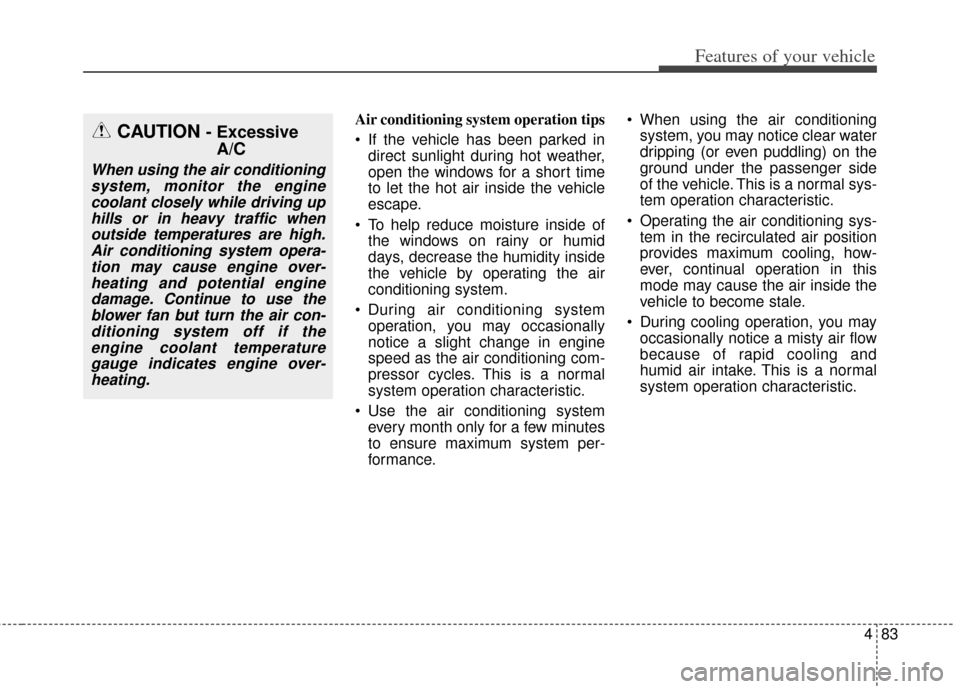
483
Features of your vehicle
Air conditioning system operation tips
If the vehicle has been parked indirect sunlight during hot weather,
open the windows for a short time
to let the hot air inside the vehicle
escape.
To help reduce moisture inside of the windows on rainy or humid
days, decrease the humidity inside
the vehicle by operating the air
conditioning system.
During air conditioning system operation, you may occasionally
notice a slight change in engine
speed as the air conditioning com-
pressor cycles. This is a normal
system operation characteristic.
Use the air conditioning system every month only for a few minutes
to ensure maximum system per-
formance. When using the air conditioning
system, you may notice clear water
dripping (or even puddling) on the
ground under the passenger side
of the vehicle. This is a normal sys-
tem operation characteristic.
Operating the air conditioning sys- tem in the recirculated air position
provides maximum cooling, how-
ever, continual operation in this
mode may cause the air inside the
vehicle to become stale.
During cooling operation, you may occasionally notice a misty air flow
because of rapid cooling and
humid air intake. This is a normal
system operation characteristic.CAUTION - ExcessiveA/C
When using the air conditioning
system, monitor the enginecoolant closely while driving uphills or in heavy traffic whenoutside temperatures are high.Air conditioning system opera-tion may cause engine over-heating and potential enginedamage. Continue to use theblower fan but turn the air con-ditioning system off if theengine coolant temperaturegauge indicates engine over-heating.
Page 163 of 393
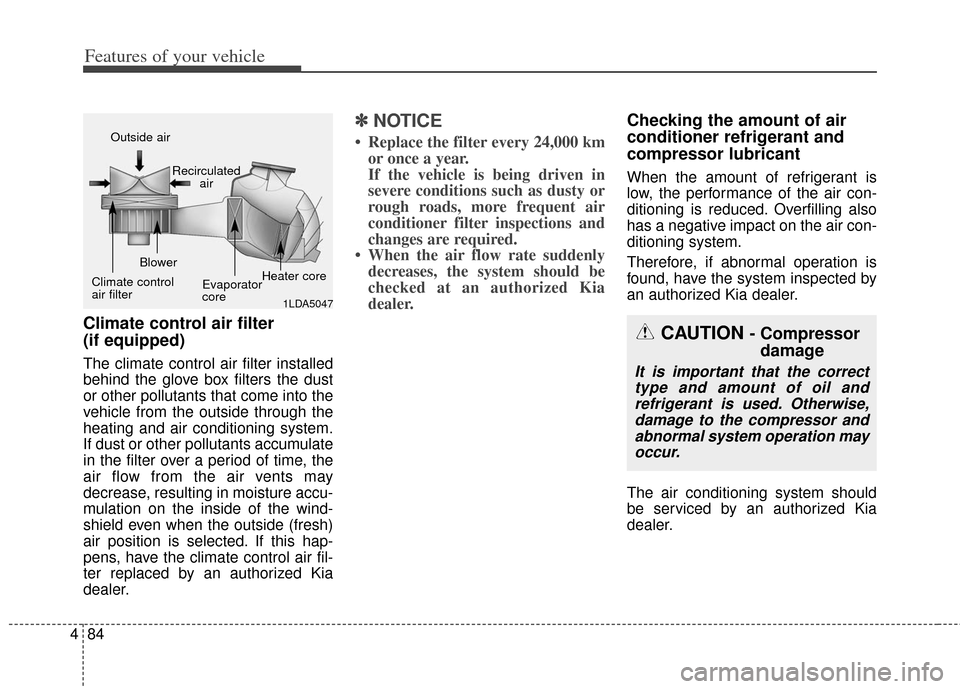
Features of your vehicle
84
4
Climate control air filter
(if equipped)
The climate control air filter installed
behind the glove box filters the dust
or other pollutants that come into the
vehicle from the outside through the
heating and air conditioning system.
If dust or other pollutants accumulate
in the filter over a period of time, the
air flow from the air vents may
decrease, resulting in moisture accu-
mulation on the inside of the wind-
shield even when the outside (fresh)
air position is selected. If this hap-
pens, have the climate control air fil-
ter replaced by an authorized Kia
dealer.
✽ ✽
NOTICE
• Replace the filter every 24,000 km
or once a year.
If the vehicle is being driven in
severe conditions such as dusty or
rough roads, more frequent air
conditioner filter inspections and
changes are required.
• When the air flow rate suddenly decreases, the system should be
checked at an authorized Kia
dealer.
Checking the amount of air
conditioner refrigerant and
compressor lubricant
When the amount of refrigerant is
low, the performance of the air con-
ditioning is reduced. Overfilling also
has a negative impact on the air con-
ditioning system.
Therefore, if abnormal operation is
found, have the system inspected by
an authorized Kia dealer.
The air conditioning system should
be serviced by an authorized Kia
dealer.
1LDA5047
Outside air
Recirculatedair
Climate control
air filter Blower
Evaporator
coreHeater core
CAUTION - Compressor
damage
It is important that the correct
type and amount of oil andrefrigerant is used. Otherwise,damage to the compressor andabnormal system operation mayoccur.